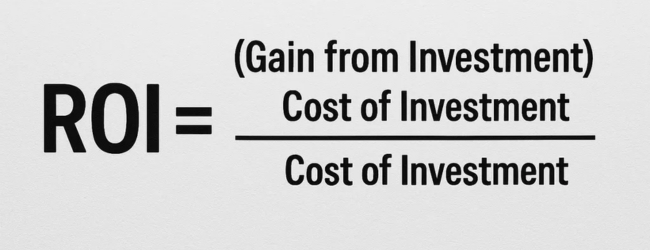Table of contents
ROI in Digital Marketing
In the dynamic landscape of digital marketing, where every click, impression, and conversion matters, understanding and optimizing your Return on Investment (ROI) is paramount. It’s the compass that guides your marketing efforts, ensuring that your investments translate into tangible business growth.
Why ROI Matters More Than Ever
In a data-driven world, gut feelings alone won’t cut it. ROI measurement provides the concrete evidence you need to:
- Validate Marketing Strategies: Prove the effectiveness of your campaigns with hard numbers.
- Secure Budget Allocation: Demonstrate the value of your marketing spend to stakeholders.
- Identify Growth Opportunities: Pinpoint high-performing channels and tactics for scale.
- Minimize Waste: Eliminate ineffective strategies and redirect resources to what works.
The Fundamental Equation: Demystifying ROI Calculation
The basic formula for ROI remains consistent:

However, the challenge lies in accurately determining “Net Profit” and “Cost of Investment.” This requires meticulous tracking and attribution.
ALSO READ | Instagram Monetization: How to Earn Money from Instagram?
Navigating the Sea of Digital Marketing Metrics: A Comprehensive Guide
In the vast ocean of digital marketing, metrics are your compass and stars. They provide direction, illuminate your progress, and warn you of potential hazards. Understanding and utilizing these metrics effectively is crucial for maximizing your ROI and achieving your marketing goals.
Why Metrics Matter: The Foundation of Data-Driven Marketing
- Objective Measurement: Metrics provide quantifiable data to assess campaign performance.
- Performance Tracking: They allow you to monitor trends and identify areas for improvement.
- Strategic Decision-Making: Data-driven insights inform strategic decisions and optimize resource allocation.
- Accountability and Transparency: Metrics provide evidence of your marketing efforts’ impact.
Key Metrics to Master:
- Conversion Rate (CR):
- Definition: The percentage of visitors who complete a desired action (e.g., purchase, sign-up, download).
- Significance: Measures the effectiveness of your website or landing pages in converting visitors into customers.
- Calculation: CR=(Total Number of Visitors/Number of Conversions)×100
- Optimization: Improve landing page design, optimize call-to-actions, and enhance user experience.
- Customer Acquisition Cost (CAC):
- Definition: The total cost of acquiring a new customer.
- Significance: Helps you understand the efficiency of your marketing spend and identify cost-effective acquisition strategies.
- Calculation: CAC=(Number of New Customers Acquired / Total Marketing Spend)
- Optimization: Refine targeting, optimize ad campaigns, and improve conversion rates.
- Customer Lifetime Value (CLTV):
- Definition: The projected revenue a customer will generate throughout their relationship with your brand.
- Significance: Provides a long-term perspective on customer value and informs customer retention strategies.
- Calculation: (This can be complex and vary by industry, common calculations involve average purchase value, purchase frequency and customer lifespan)
- Optimization: Enhance customer experience, offer loyalty programs, and provide personalized services.
- Cost Per Click (CPC):
- Definition: The amount you pay for each click on your ads.
- Significance: Essential for managing paid advertising budgets and optimizing ad campaigns.
- Calculation: CPC=Number of Clicks/Total Ad Spend
- Optimization: Improve ad targeting, optimize ad creatives, and refine keyword bidding strategies.
- Cost Per Lead (CPL):
- Definition: The cost of generating a single lead.
- Significance: Important for lead generation campaigns and measuring the efficiency of lead acquisition efforts.
- Calculation: CPL=Number of Leads Generated / Total Lead Generation Spend
- Optimization: Optimize landing pages, improve lead capture forms, and refine targeting.
- Return on Ad Spend (ROAS):
- Definition: The revenue generated for every dollar spent on advertising.
- Significance: Specifically measures the effectiveness of paid advertising campaigns.
- Calculation: ROAS=Total Ad SpendRevenue Generated from Ads
- Optimization: Optimize ad creatives, refine targeting, and improve landing page experience.
- Attribution Modeling:
- Definition: The process of assigning credit to different touchpoints in the customer journey.
- Significance: Provides a comprehensive view of the customer journey and helps identify the most effective marketing channels.
- Types: First-click, last-click, linear, time-decay, and data-driven attribution.
- Implementation: Use attribution modeling tools and techniques to track customer interactions.
- Website Traffic Metrics:
- Unique Visitors: The number of distinct individuals who visit your website.
- Pageviews: The total number of pages viewed on your website.
- Bounce Rate: The percentage of visitors who leave your website after viewing only one page.
- Average Session Duration: The average time visitors spend on your website.
- Significance: Provides insights into website performance, user engagement, and content effectiveness.
- Analysis: Use Google Analytics to track and analyze website traffic metrics.
- Social Media Metrics:
- Engagement Rate: The percentage of users who interact with your social media content (likes, shares, comments).
- Reach: The number of unique users who saw your social media content.
- Follower Growth: The rate at which your social media following is increasing.
- Click-Through Rate (CTR): The percentage of users who click on links in your social media posts.
- Significance: Measures the effectiveness of social media campaigns and audience engagement.
- Analysis: Use social media analytics tools to track and analyze performance.
💡 Pro Tip: If you want to start a Business but have too many doubts, connect with a Manufacturing Business expert from Boss Wallah for guidance – https://bw1.in/1116
Key Considerations:
- Alignment with Goals: Ensure your metrics align with your specific marketing objectives.
- Contextual Analysis: Analyze metrics in context, considering industry benchmarks and campaign specifics.
- Continuous Monitoring: Regularly monitor and analyze metrics to identify trends and optimize performance.
- Tool Utilization: Leverage analytics tools to streamline data collection and analysis.
Strategies for Amplifying Your ROI

- Data-Driven Decision Making: Rely on analytics to inform your strategies and optimize campaigns.
- Personalization and Segmentation: Tailor your messaging to specific audience segments for increased engagement.
- Content Optimization: Create high-quality, relevant content that resonates with your target audience.
- Multi-Channel Integration: Ensure a seamless customer experience across all digital channels.
- Continuous Testing and Optimization: Regularly test different elements of your campaigns to identify what performs best.
- Implement Marketing Automation: Automate repetitive tasks and personalize customer interactions.
- Focus on Customer Retention: Retaining existing customers is often more cost-effective than acquiring new ones.
- Analyze and Adjust: Regularly review your campaign performance and make necessary adjustments.
Tools to Empower Your ROI Analysis
- Google Analytics 4 (GA4): Provides comprehensive website and app analytics.
- Marketing Automation Platforms: Tools like HubSpot, Marketo, and Pardot streamline marketing efforts and track performance.
- CRM Systems: Tools like Salesforce and Zoho CRM help manage customer relationships and track sales.
- Social Media Analytics Tools: Platforms like Sprout Social and Hootsuite offer insights into social media performance.
- Attribution Modeling Tools: Tools like Google Attribution and Ruler Analytics help track the customer journey.
Key Takeaways
- ROI is the cornerstone of successful digital marketing.
- Accurate data collection and analysis are essential for ROI measurement.
- Understanding customer lifetime value (CLTV) provides a long-term perspective.
- Continuous optimization and testing are crucial for maximizing returns.
- Utilizing the right tools can streamline ROI tracking and analysis.
- Effective attribution modeling is crucial to understanding the full marketing picture.
- Personalization and segmentation improve campaign effectiveness.
- Customer retention significantly impacts long term ROI.
Need Expert Guidance?
Starting a business can be challenging, but you don’t have to do it alone! At Boss Wallah, our 2,000+ business experts are ready to provide valuable insights and guidance. Whether you need help with marketing, finance, sourcing, or any other area of any business, our business experts are here to help you succeed- https://bw1.in/1116
Confused about Which Business to Start?
Want to start your own business but unsure which one to choose? Explore Boss Wallah, where you’ll find 500+ courses by successful business owners, featuring practical, step-by-step guides on starting and growing various businesses. Find your perfect business idea today – https://bw1.in/1111
Conclusion
Mastering the art of ROI measurement in digital marketing is an ongoing journey. By embracing data-driven strategies, leveraging the right tools, and continuously optimizing your campaigns, you can unlock sustainable growth and achieve remarkable results.
FAQs
- How do I accurately attribute revenue to specific marketing channels?
- Use attribution modeling tools and techniques to understand the customer journey and assign credit to each touchpoint.
- What is the difference between ROAS and ROI?
- ROAS focuses specifically on the revenue generated from ad spend, while ROI considers the overall profitability of a marketing campaign.
- How can I improve my customer retention rate?
- Provide excellent customer service, personalize customer experiences, and offer loyalty programs.
- How do I calculate the CLTV of my customers?
- Use historical data to predict the total revenue a customer will generate over their relationship with your business.
- What are the common pitfalls in ROI calculation?
- Ignoring indirect costs, failing to track all relevant metrics, and using inaccurate attribution models.
- How do I determine which metrics are most important for my business?
- Align your metrics with your specific business goals and objectives.
- How can I use A/B testing to improve my ROI?
- By testing different variations of your ads, landing pages, and email campaigns to identify which versions perform best.
- What role does content marketing play in ROI?
- Content marketing builds trust, generates leads, and drives conversions, contributing to long-term ROI.


